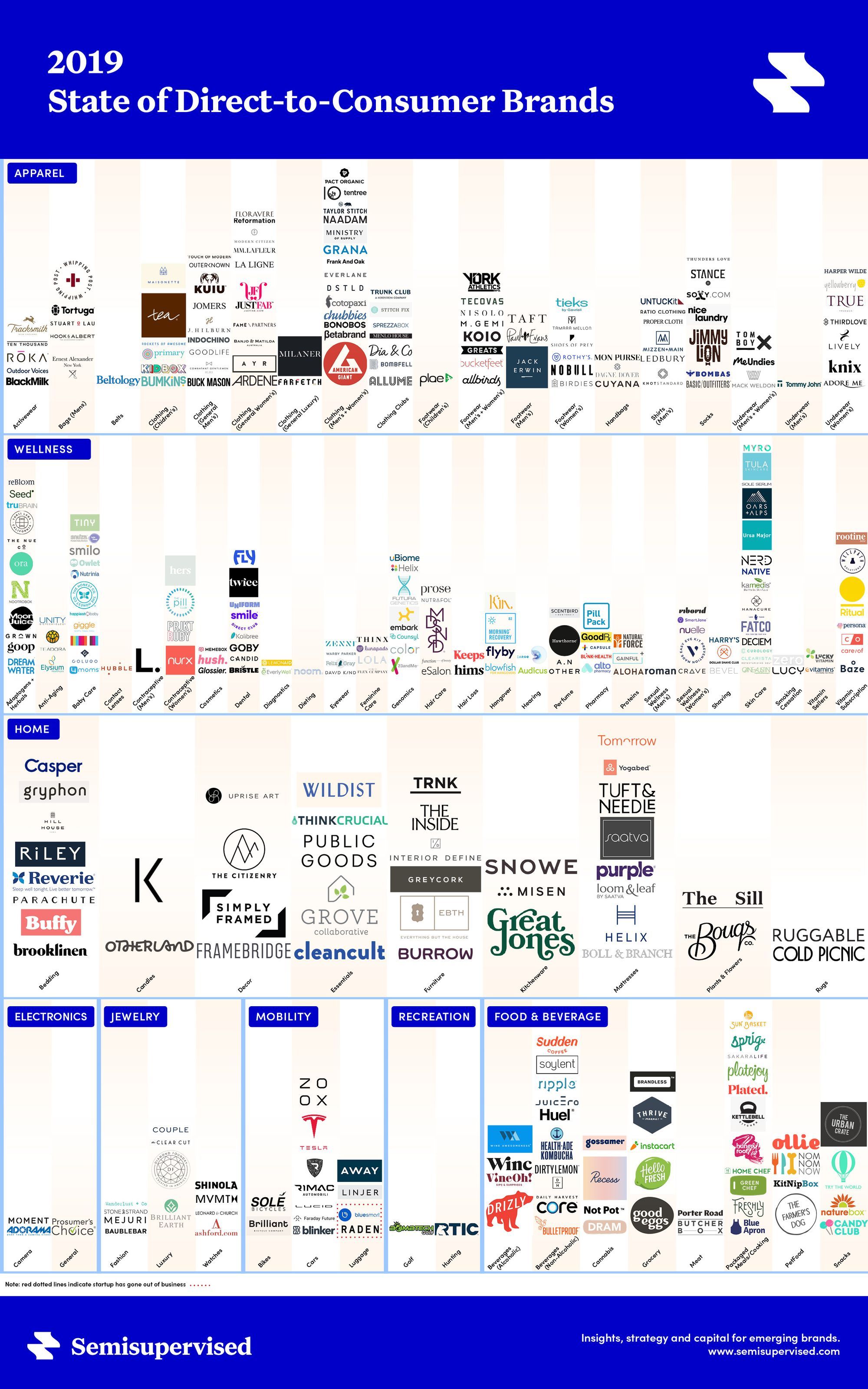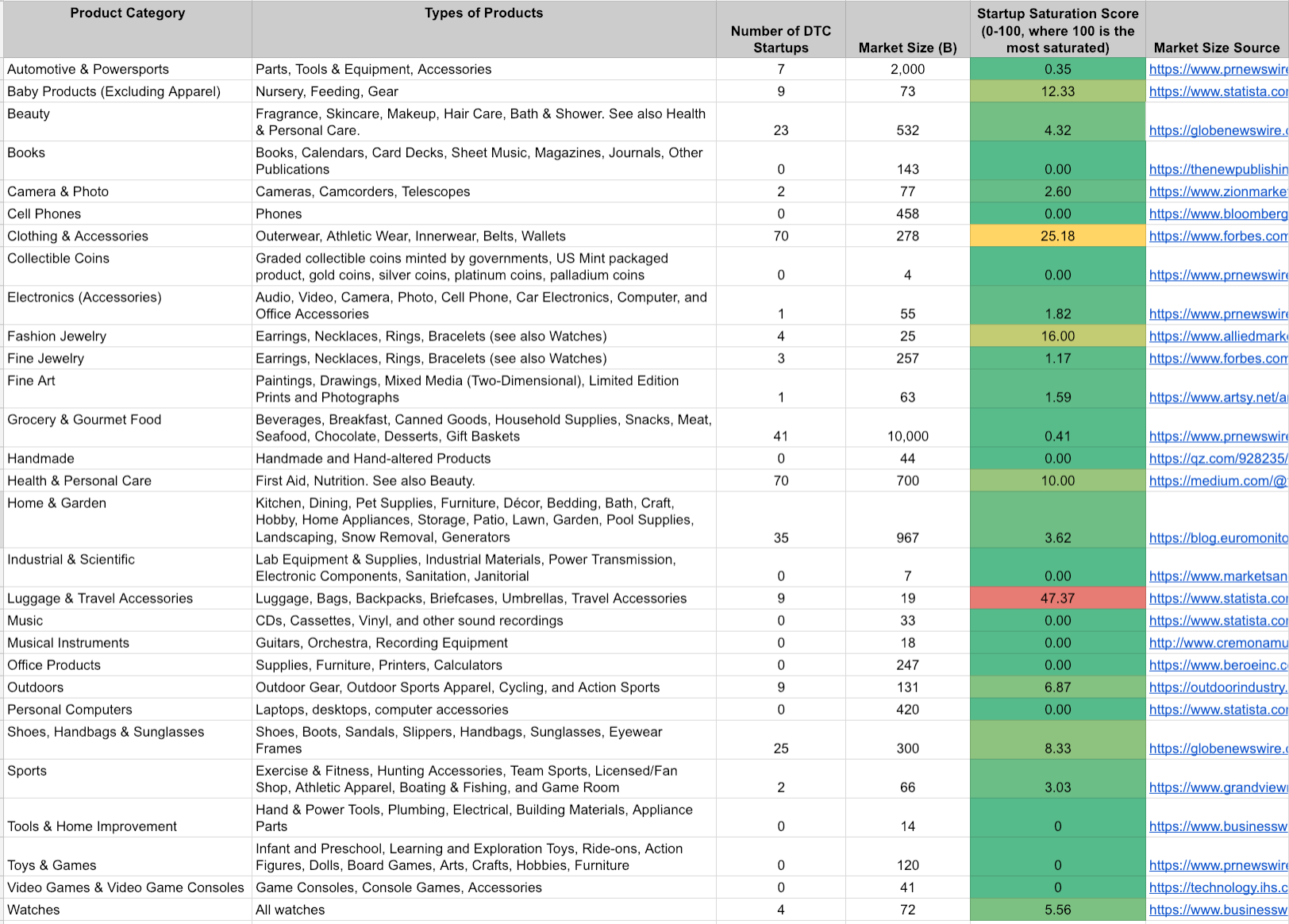How many millennial-magnet consumer brands can one society handle?
With new brands’ ads popping up on Instagram stories every single day, it makes sense to ask.
Have we reached market saturation for DTC (direct-to-consumer) brands? Where do we stand today with DTC? How did we get here, and where are we headed?
Part I: Where do we stand today with DTC?
Here’s a snapshot of the current DTC landscape broken down into eight broad categories: Apparel, Wellness, Home, Food & Bev, Electronics, Jewelry, Mobility, and Recreation.

View or download a hi-res PDF version here
The large majority of the 320+ brands included above have a few things in common:
- They sell mainly physical goods as opposed to services like home cleaning or music streaming.
- They’re mostly vertical brands, meaning they produce and distribute their own physical goods, rather than acting as marketplaces that sell many brands.
- For the most part, they’ve all been backed by venture capital at some stage(s).
Note: there are some exceptions to these rules, especially break-through subscription services and marketplaces.
Before we analyze the current state of affairs, let’s do a quick recap of how we got here:
1995–2005: eCommerce 1.0 begins with online marketplaces (Amazon, eBay, Newegg) selling existing big-name consumer brands in the mid 90’s. These sites build up early eCommerce market share and SEO rankings for the first decade of online shopping.
2005–2010: What a16z refers to as the beginning of eCommerce 2.0. eCommerce platforms like Shopify, BigCommerce, and Magento make it possible for vertical brands to make and sell their own wares. Betabrand, Bonobos, and America’s sweetheart Warby Parker, are early pioneers here (Disclosure: the author co-founded Betabrand). Also during this period, we see an explosion of experiments in new business models like flash sale retail (Gilt and Groupon) as well as subscription products (Trunk Club and ThredUp).
2010-present: We’re calling this period eCommerce 2.5. You’re seeing a more sophisticated cadre of vertical brands emerge (Allbirds, Away, Glossier). All stages of the vertical chain improve — product development, manufacturing, customer feedback loops, customer experience, mobile shopping experience, payment options, the rise of purpose-driven products and, spurred on by a competitive market, big investments in Brand.
Over the last 15 years in eCommerce 2.0 and 2.5, the categories have shifted dramatically.
If eCommerce 2.0 was all about Apparel, Bags, and Accessories, eCommerce 2.5 is about Grocery, Health, and Home.
DTC Home and Grocery brands have quickly spread from simply taking up space in your refrigerator (Blue Apron, Freshly, Sunbasket) and living room (Burrow, Interior Define, TRNK), to invading every nook and cranny of your house: your medicine cabinet, shower, linen closet, and every kitchen cabinet and countertop.
With three relatively new DTC kitchen brands on the scene (Snowe, Misen, Great Jones), plus a few more rumored to be on their way this year, 2019 is shaping up to be the year of the kitchen wars.
DTC Health is also on a tear with Hubble, Hims, Hers, Care/Of, etc. For illustration purposes I combined Health and Beauty together into the macro-category of Wellness in the infographic above. Wellness includes some of the hottest sub-categories right now, including vitamins and supplements, skin care, genomics, as well as 20 others that are ripe for innovation.
Part II: Have we gone too far? Isn’t every category saturated?
The infographic above is helpful in wrapping your head around the DTC landscape and to see which categories were hit hardest in the early eCommerce days. But it tells you nothing about the upside potential of each category. To get just a quick glimpse of these opportunities, we categorized the DTC startups from the infographic by the position they would occupy in Amazon’s Seller product categories. We found rough market size data for each category and came up with a simple ratio called the Startup Saturation Score, which = ((number of startups in a category / market size of that category)*100). The color-coded column shows the score for each category (scale is 0–100, where 100 is the most saturated):

Note: There are a few more startups listed on the infographic than this sheet, but directionally it’s still accurate.
This should not be construed as a thorough examination of category saturation or overall market saturation for DTC brands. There’s a lot more nuance to answering questions of market saturation, like accounting for specific subcategory saturation (ahem, mattresses) as well as the major incumbents and innovative crowdfunded or family-office-funded brands.
However, when you take a step back and just look at a) the relative scores of certain categories compared to others (e.g. luggage compared to fine jewelry) and b) the larger DTC opportunity, especially in certain categories, in this light (e.g. how massive Grocery is alone), you start to see big swaths of white space. Or at least that’s what we see as optimistic (delusional?) entrepreneurs.
By this simple measure, the most saturated categories are luggage, fashion jewelry, and clothing. Note, too, that “smart luggage” brands Raden and Bluesmart shut down last year due ostensibly to changes in airline policies, though market saturation was likely an additional factor. The majority of categories on this list, however, still have a ton of headroom for DTC challenger brands.
Part III: Where are we headed?
Over the next decade, we’ll see the next phase of DTC — eCommerce 3.0 — take shape and accelerate. The lasting brands will win on trust, a fluid shopper experience, and a true sense of purpose. Beyond Home, Health, and Grocery categories continuing to proliferate online, some overlooked categories to watch out for (and innovate in!) over the next few years are: Outdoor Recreation, Sports, Fine Jewelry, Office Products, and Home Improvement. These categories all enjoy large global market sizes, and yet have seen relatively little innovation in the DTC arena so far. Furthermore, there are many additional categories and subcategories listed above that remain largely unchallenged by the vanguards of DTC.
A quick side-bar on venture capital: As Teddy Citrin from Greylock laid out, there are over a dozen different factors (e.g. AOV, purchase frequency, barrier to entry, etc.) that go into making a DTC brand attractive from a venture perspective. Plus, as we head into a more bearish market this year, if you’re hoping to venture fund a DTC brand, you’ll need to have even more proof points than in years past.
And remember, venture funding isn’t right for every product. Your goal as a challenger brand is to create an innovative and sustainable business, and the sustainability piece can sometimes be at odds with the expectations of venture growth. And according to Digiday, there’s also some early evidence that DTC brands (Rothy’s, Buffy, AYR to name a few) that have shown more restraint in fundraising are potentially better set-up for long-term sustainability.
So, as a consumer, you can expect your Instagram stories to continue to blow up with newcomers (and legacy brands) vying for your attention. As a brand, you can expect your CPA’s to rise on the usual-suspect-channels, and for shoppers to demand more from your end-to-end experience and to want to hear about purpose, not just product. In closing, since no article written early in the year would be complete without one, here’s a 2019 listicle to get your DTC motors revved:
Part IV: DTC Thought-Sparkers for 2019:
- Let’s Go: The DTC eComm revolution is still in early innings, with eComm still only representing ~10% of retail sales in the U.S., according to the U.S. Department of Commerce.
- That’s It: We’re long overdue for everyone to stop calling every DTC brand the Warby Parker of X. I still see articles saying this, please stop.
- Do Better: Cutting out the middleman is not enough to win — that’s not innovation anymore, and hasn’t been for a number of years.
- Other Ways to Win: Be an early mover/tester in a new acquisition channel, innovate in supply chain and speed of delivery (Dirty Lemon outperforming Amazon here), machine learning for consumer insights, investing in community and environmental impact, shopper experience, and building brand trust.
- Frenemy of the State: Amazon is more of a frenemy than an enemy if you’re a DNVB. Think of it as another SEM acquisition channel. Consider that a failure to defend your turf on Amazon as a seller could lead to knockoffs of your brand and people bidding on your brand keywords.
- CBD DTC: Expect to see lots of new DTC brands in Home & Garden; already seeing the Kitchen explode in 2019 and Food/Grocery will continue to boom. Other BIG areas of opportunity are in Outdoor Recreation, Sports, Fine Jewelry, Office, and Home Improvement. Oh, and CBD everything of course.
- Back to Brick: Keep in mind CPA’s on paid social are rising, so getting a broad mix of marketing channels and considering pop-up retail or committed retail as one of those can be helpful in attracting a lot of new faces. Just because you’re selling in “traditional” brick and mortar, doesn’t mean you have to be traditional in your methods — especially in sophistication using data to your advantage.
- Purpose: a) Have one, and b) make sure people know what it is. Impact is still relatively a low priority for the DTC brands above, as less than 10% of the brands above are registered BCorps, for instance, which points to an opportunity for eCommerce 3.0 brands to set a new precedent. As Blackrock CEO Larry Fink laid out in his year-end letter, all businesses will be measured moving forward not just on profit, but on purpose.
- Scuba Worthy: A few CPG subcategories that are experiencing massive upheaval deserve a deeper dive soon: Adaptogens (Moon Juice, Sunpotion), Cannabis (Not Pot, Dram), Skincare (The Neu Co, Ursa Major), and Ready-to-Drink Beverages (Dirty Lemon, REBBL).
- Forget Millennials: Which DTC brands are doing well with Gen X? What about Gen Z and Gen Alpha? If you know, feel free to leave a comment below. We want to dig further here.
About the author:
Jared Graf is an entrepreneur and marketer. He previously co-founded Betabrand, a crowdfunding platform for apparel, and led marketing teams at Hipcamp and Fluent City. He now runs the digital marketing and startup studio Semisupervised.
Extra Resources:
If you’re interested in funding for your DTC brand, here’s a quick round-up of some strategic DTC funding partners:
- Idea Farm
- Innovation Dept.
- Human Ventures
- Brand Foundry
- Forerunner
- Amity Ventures
- Greycroft
- Sound Ventures
- BrandProject
Special Thanks: Mike Packles for reading early drafts of this. Teddy Citrin from Greycroft for his articles on the 2016 DTC Landscape and DTC healthcare, as well as Chad Rubin from Skubana for his compilation of cool DTC brands and Randall Rothenberg of IAB and his team for making their 2018 Annual Leadership Meeting deck available online. All three of these resources were very helpful in adding to the compilation of 320+ DTC brands in the infographic above.
Disclaimers: Market size numbers, the specific number of startups in each category, as well as how the startups were categorized are meant to be directional and approximate and are not to be taken as absolute truth. As we noted in the article, this is only a slice of DTC brands; mainly venture-backed startups vs. all direct brands coming out of Kickstarter, Indiegogo, the garage down the street, etc. So there will be many direct brands that didn’t make this list. We also purposefully didn’t go too deep on subscription boxes because there’s such a large volume of them that are cross-category, so it seemed like it would introduce a lot of noise to the analysis. However we did include a few subscription boxes that we think have broken through the noise. All of that being said, if you know of a startup innovating in one of these categories that we left out that you’d like us to consider including in an update, please do let us know!



